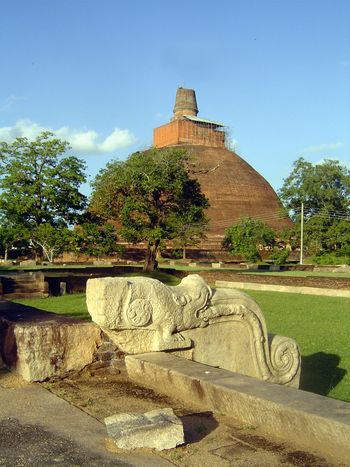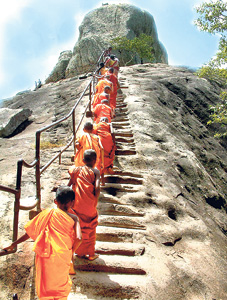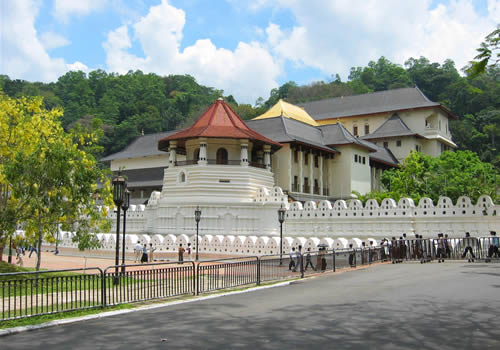Anuradhapura

Anuradhapura, Sri Lanka’s first capital was the greatest monastic city of the ancient world. It was royal capital for more than 100 Sri Lankan kings and at its heights was home to thousands of monks from dozens of monasteries. Originally founded by a minister called Anuradha, in the 4th century BC, it became the capital of Sri Lanka two centuries later. After a long and sometimes bloody history, it was abandoned in 1073 and is now today the most important religious and cultural site in Sri Lanka. The ruins of Mahavihara, the first Monastery, which served as the seat of Theravada Buddhism, as well as the Thuparamaya, built by King Devanam Piyatissa in 250 B.C.E, the Ruwanwelisaya, and several other monasteries and temples can be seen. The ancient Bo Tree, which was originally a branch of the Bo tree in Budda Gaya under which Lord Buddha attained enlightenment and brought to Sri Lanka by Emperor Asoka’s daughter, Princess Sangamiita, also is in Anuradhapura.
Mihintale

TriangleMihintale, one of Sri Lanka’s most significant religious sites, lies 13kms east of Anuradhapura and is where Buddhism originated on the island. In 247 BC King Devanampiya Tissa of Anuradhapura, was deer hunting on the plains beneath Mihintale, and met Mahinda, son of the Indian Buddhist emperor, and chose the path of Buddhism for the Sinhalese nation following Mahinda’s persuasion. Anuradhapura and Mihintale’s ancient, spiritual ruins can leave you in awe. It can be an inspiring visit at all times of the year, especially on the full moon day of May when Vesak is celebrated in remembrance of Lord Buddha’s birth, enlightenment and Prinivanpama (his passing) and in June, when the festival of Poson is celebrated when the introduction of Buddhism to Sri Lanka by Mahinda, is remembered. Thousands of pilgrims and devotees flock to these Buddhist shrines from across the country to pay homage to the Buddha, Dhamma (Buddha’s teachings) and the Sangha (the Budhhist monks).
Aukana
Aukana

One of Sri Lanka’s most perfect and elegant statues, the Aukana Buddha lies to the west of the large Kala Wewa tank. Creation of both the temple and the tank (reservoir) is attributed to King Dhatusena in the 5th century. The statue stands 12m high, carved from a single rock and is completely free-standing. It is an example of the Abhayamudra Buddha, showing superhuman qualities. The right handed gesture, raised to the right shoulder with the palm spread, signifies lack of fear. The left hands position draws the worshipper to Buddha for release from their earthly bonds. The statue has gained significance in recent times due to the destruction of similar Buddha in Afganistan. The Aukana Buddha can be visited en route to Anaradhapura and can easily be combined with the ancient monastery site of Sasseruwa. It only takes a maximum of 45 minutes to visit the site. The nearby Kala Wewa tank (reservoir) is also an excellent place to stop off and have a picnic with a most satisfying view.
Yapahuwa

Excursion profile: After the fall of the great city of Polonnuruwa, the Kandyan kings fled to a succession of inaccessible crags, bearing with them the sacred tooth relic of the Buddha. One of them was Yapahuwa, a huge, yet little-visited rock fortress a little way off the Kurunegala-Anuradhapura road, and one of the great architectural sites of the island. This early 13th century stronghold is reminiscent of Sigiriya, a massive granite outcrop, set in a shady location, and rising 100m above the plains below. King Bhuvanekabahu I developed Yapahuwa, building a palace and a temple, which housed the famous tooth relic for 11 years. After Yapahuwa was abandoned, Buddhist monks took it over and still remain today. Yapahuwa is worthy of a visit as it is relatively quick to see, interesting and beautiful. Although not as significant as other Cultural Triangle sites it does have a special individual charm.
Ritigala
Ritigala

Ritigala nestles deep inside the Ritigala Strict Nature Reserve, found just off the Anuradhapura-Habarana road, and is the partially excavated ruins of an extensive Buddhist Monastery. It was abandoned following invasions in 10th and 11th centuries and today holds special appeal with its curious blend of nano-safari and archaeology. Walking around the beautiful ruins does certainly give you a feeling of adventures in search of mythical pasts; it is easy to imagine yourself as Indiana Jones whilst clambering over the overgrown relics of a forgotten time.
Dambulla Caves
Dambulla Caves

Dambulla Cave Temple at first came into use as a refuge for King Valagambahu in 1st century BC. Concealed by the local monks, upon returning from exile to his throne at Anuradhapura, he had the magnificent cave temple built for them. The cave temple consists of a complex of Buddhist image houses. Its rock ceiling is one large sweep of colorful frescoes, some of which dates back to over 2,000 years, which depicts Buddhist mythology, and the tales of the Buddha's previous births. This cave temple has the largest number of Buddha statues all housed in one place, including a 14 meter long, colossal figure of the recumbent Buddha carved out of the rock.
Polonnaruwa

Polonnuruwa became Sri Lanka’s royal medieval capital in 1073. For nearly a century it had been a military base for invading Chola tribes, from southern India, until they were overthrown by the Sinhalese king, Vijayabahu I in 1070. The next king, Parakramabahu I, was the main driving force behind the development of Polonnuruwa. It remained Sri Lanka’s capital until the late 13th century, but became increasingly susceptible to Chola invasions and it became lost to the jungle once more as the capital drifted south-west. Today, the ancient city’s ruins remain in remarkably good nick, and are a fascinating site to visit. The most impressive are the ancient sculptures of Lord Buddha at the Gal Viahara cut into Granite stone dating back to the middle of the 12th century. The entire sculpture consists of four colossal statues of Buddha - a samadhi image in meditation posture, a seated Buddha image inside a cave, a standing Buddha image which is 23 ft in height, and recumbent Buddha image measuring 46 ft, depicting the passing away.
Alu-Vihara Caves
Alu-Vihara Caves

Located 26 km. from Kandy in Matale is the ancient Aluvihara cave temple, which is of great significance in the history of Buddhism. It was here that the oral teachings of the Buddha - the Tripitaka--were committed to writing for the first time in 3rd century AD. The language of these Buddhist scriptures, Pali, influenced the development of the Sinhala langugage. The Alulvihara temple consists of large caves with Buddha images and frescoes. Further in is a cave dedicated to Ven. Buddhagosa, a Buddhist monk, who spent several years in this cave documenting the doctrines of the Buddha in Pali.
Temple of tooth - Kandy
Temple of tooth - Kandy

A sacred tooth relic of the Lord Buddha was brought to Sri Lanka in 4th Century A.D. and was enshrined within the Dalanda Maligawa, or the Temple of the Tooth. This sacred relic has ever since been the symbol of sovereignty for the Sinhalese kings and always enshrined in great splendour. Kandy’s Dalada Maligawa is a magnificent shrine, with decorative walls, golden roof and fine woodwork and its 16th – 19th century ambience still vividly alive. Religious services (pooja) are held daily at dawn, mid-day, and in the evening and can be viewed by visitors. The services are accompanied with traditional music and drumming. Although the tooth relic cannot be seen within the temple as it is securely enshrined within, on the Esala full moon day of July/August each year, the sacred tooth relic, encased in a golden casket, is taken in procession (a perahara), on the back of the temple elephant along the streets of Kandy for all to see.
Adam's Peak
Adam's Peak

Sri Pada, or Adam’s Peak, is sacred to all four religious groups in Sri Lanka – the Buddhists, Hindus, Muslims, and the Christians. The giant footprint at the top is variously claimed as an imprint either of Lord Buddha, God Shiva, Adam, or St. Thomas the Christian Apostle who preached in south India. This 2,234 meter mountain is a pilgrimage site to thousands of devotees from many faiths. Young and old give courage to each other and recite traditional stanzas while climbing to the peak. The climb is best attempted at night where you reach the mountain top to see the sunrise and the awe-inspiring view from the top. It can be one of the most moving experiences in Sri Lanka. During pilgrimage season, from December to April, the stepped mountainside is lit by strip lights and rudimentary stalls offering refreshments to fire your resolve to reach the summit.